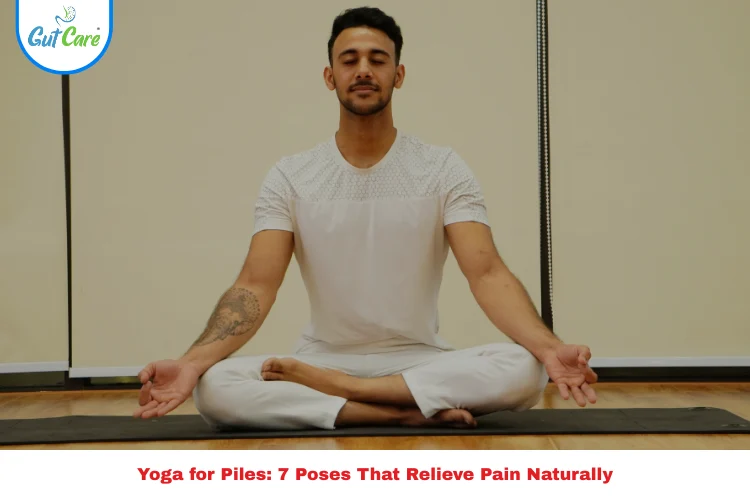Dealing with piles, or hemorrhoids, can be uncomfortable and disruptive in your everyday life. In many situations, piles may require medical treatment to address, especially with severe cases—but for those who don’t have chronic cases, there are natural ways to find relief. One area many people look at for relief from piles is yoga. Improving circulation, digesting food, reducing inflammation, relieving pressure in the rectal area—and potentially reducing how painful piles can be— yoga for piles is becoming a popular gentle, non-invasive approach to remedy piles. Can yoga reduce your piles? Let’s take a look at the best yoga poses to help you heal (and feel more comfortable).
Can Yoga Reduce Piles?
Yes, yoga for piles can really alleviate the symptoms of hemorrhoids. Although it’s not a remedy for bad cases of hemorrhoids, it contributes positively to the circulation, lack of constipation, strengthening pelvic muscles, and the relieve of pressure on the veins in the rectal area. By doing a few yoga poses regularly, along with a healthy diet and drinking enough water, will be a simple but effective way to manage piles in the long-term.
1. Malasana (Garland Pose)
Benefits: Opens the hips and lower back, stimulates digestion, and reduces constipation.
How to Do It:
- Stand with feet shoulder-width apart.
- Slowly bend your knees and lower your hips into a squat.
- Keep your palms together in a prayer position at your chest.
- Elbows should gently press into the knees to widen the hips.
- Hold the pose for 30 seconds to 1 minute, breathing deeply.
2. Pawanmuktasana (Wind-Relieving Pose)
Benefits: Reduces gas, bloating, and stimulates bowel movement, which can help ease piles.
How to Do It:
- Lie on your back with your legs extended.
- On your inhale, bend and bring your right knee into your chest.
- Engage your arms around your knee and gently pull it into your abdomen.
- Hold for 20-30 seconds, then repeat with your left leg, and finally with your knees together for a little deeper release.
3. Balasana (Child’s Pose)
Benefits: Relaxes the lower back and abdomen, helps ease pain, and reduces mental stress.
How to Do It:
- Kneel on the mat with toes together and knees apart.
- Sit back on your heels and stretch your arms forward.
- Rest your forehead on the floor.
- Breathe deeply and stay in the pose for 1–2 minutes.
4. Viparita Karani (Legs Up the Wall Pose)
Benefits: Improves blood circulation, reduces pressure in the rectal area, and promotes relaxation.
How to Do It:
- Sit sideways against a wall.
- Swing your legs up and lie back with your arms by your sides.
- Make sure your legs are fully extended and resting against the wall.
- Stay in this pose for 5-10 minutes.
5. Ardha Matsyendrasana (Half Spinal Twist)
Benefits: Aids digestion, stimulates abdominal organs, and relieves constipation.
How to Do It:
- Sit with legs extended.
- Bend your right knee and place the foot outside your left thigh.
- Place your right hand behind you and left elbow on your right knee.
- Twist your torso to the right while inhaling.
- Hold for 30 seconds and switch sides.
6. Sarvangasana (Shoulder Stand) – With Caution
Benefits: Enhances circulation and helps reduce venous pressure.
How to Do It:
- Lie on your back and lift your legs, hips, and back to form a straight line.
- Support your lower back with both hands.
- Keep legs and spine aligned.
- Hold for 15–30 seconds. Avoid this pose if you have severe piles or neck issues.
7. Setu Bandhasana (Bridge Pose)
Benefits: Strengthens pelvic muscles and reduces pressure in the anal region.
How to Do It:
- Lie on your back with knees bent and feet flat on the floor.
- Keep arms by your sides.
- Press into your feet and lift your hips toward the ceiling.
- Hold for 20–30 seconds, then slowly release.
Additional Tips for Practicing Yoga for Piles
- Always do some warm ups before doing poses.
- Practicing on an empty stomach or 3 hours after eating is best.
- Listen to your body and do not push yourself past what’s comfortable.
- If you are new to yoga make sure to see a qualified instructor, especially if you have any serious symptoms.
Final Thoughts: Why Yoga for Piles Works
By consistently doing yoga for piles, you are practicing a natural, non-invasive way to manage the symptom flare-up and prevent future flare-ups. In addition to providing physical relief, these poses help promote healthy digestion and mental space, both of which are important aspects of recovery. Remember, yoga can not be a replacement for medical treatment when your piles are more severe, but it is a helpful complementary practice.
FAQs
1. Can yoga cure piles?
No, but it helps relieve symptoms and prevent flare-ups in mild cases.
2. How often should I do yoga for piles?
4–5 times a week for 20–30 minutes is ideal.
3. Which poses should I avoid?
Avoid straining or pressure-heavy poses like headstands or intense core work.
4. Can yoga prevent piles from coming back?
Yes, by improving digestion, circulation, and reducing constipation.
5. Is it safe during a flare-up?
Gentle poses are safe, but avoid intense movements during painful episodes.




